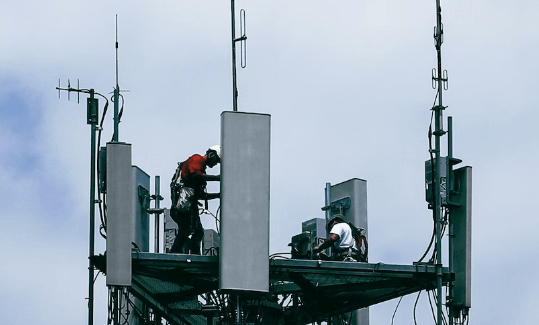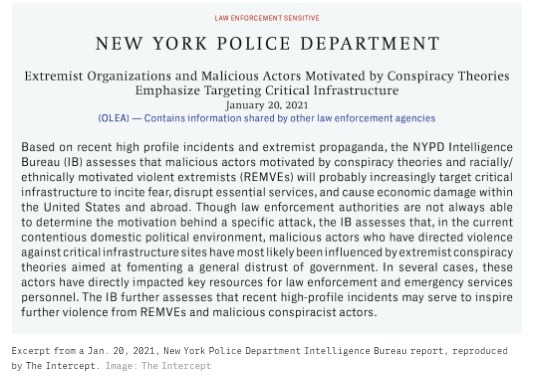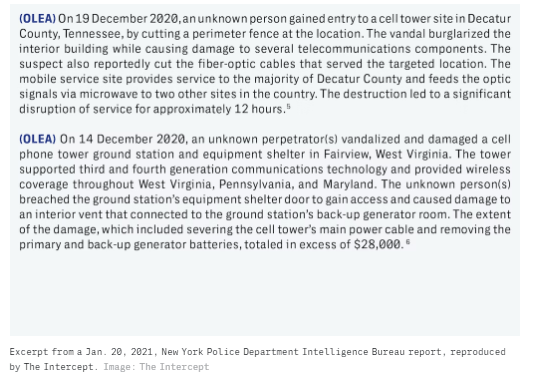According to an intelligence report by the NYPD, extremist organizations collaborated to attack crucial infrastructure and spread terror in the days following the election.

The Biden administration’s focus on repairing the country’s infrastructure has unveiled a new issue: the targeting of critical infrastructure by conspiracy theorists. The New York Police Department’s intelligence report, obtained by The Intercept, reveals that cellphone towers and other essential infrastructure have become prime targets for conspiracy theorists, especially in the aftermath of the presidential election. These individuals, often joined by far-right white supremacist groups, aim to create panic, disrupt important services, and cause economic harm in the US and overseas.
The report, which was marked as “law enforcement sensitive” and issued on January 20 by the NYPD Intelligence Bureau, attributes these attacks to the current political climate characterized by instability and conflict. The report highlights a series of sophisticated attacks, indicating a coordinated effort to plan and execute these actions.

On December 14, 2020, the report details an incident where an individual or group broke into a cellphone tower station in Fairview, West Virginia. The perpetrators cut the main power cable, and stole the primary and backup generator batteries, causing damages exceeding $28,000. The tower provided wireless coverage across West Virginia, Pennsylvania, and Maryland.
Similarly, in Tennessee on December 19, 2020, an unknown individual cut open the perimeter fence of a cell tower site and entered the premises. Once inside, they proceeded to sever the fiber-optic cables and damage various telecommunication components. The attack resulted in a significant disruption of service for about twelve hours.
A third case describes a neo-Nazi chat group whose “members strongly supported exploiting civil unrest in the United States by attacking the country’s infrastructure.” A member of the chat group, the report adds, wanted to “pursue ‘destruction where the system won’t be able to prepare for it,’ namely through attacks on U.S. bridges, railways and electrical grids.”

The Intelligence Bureau, which is responsible for gathering intelligence on terrorism and other criminal threats, blames these and similar attacks on individuals motivated by “extremist conspiracy theories aimed at fomenting a general distrust of government” and “racially/ethnically motivated violent extremists.” It stresses the threat of white supremacists to infrastructure in particular: “In recent months, white supremacist extremists, neo-Nazis, far-right Telegram groups, and online conspiracy theorists have all emphasized attacking valuable critical infrastructure targets.” Many far-right groups adhere to the “accelerationist” principle, which maintains that hastening the collapse of society will bring about political change. Targeting critical infrastructure, which impedes the state’s ability to function, is a common insurgency tactic used by militant groups worldwide.
The most detailed case depicted by the report is that of Anthony Quinn Warner, who carried out the bombing in front of an AT&T building in Nashville, Tennessee, on December 25, 2020 — the largest vehicle-borne improvised explosive device attack since the Oklahoma City bombing in 1995. While Warner was not associated with any white supremacist group, the report refers to “initial accounts that Warner was paranoid about 5G cellular networks, an important element which may take on greater significance given the apparent target.”
“Of tactical significance,” the report continues, is the fact that Warner included a prerecorded audio warning that urged passerby to evacuate the area, “indicating a likely intent to cause structural damage rather than mass casualties.”
Similarly, the Department of Homeland Security’s intelligence wing on January 5 and 6 issued three intelligence reports about vandals targeting cell towers in New York, West Virginia, and Tennessee, according to a document obtained by The Intercept. The attacks resulted in disruption of service, including to law enforcement and first responder communications.
While reports about threats to infrastructure security are not uncommon, it was unusual to see three produced in a single week, a federal law enforcement official said, especially on and before January 6, the day of the Capitol riot. The official requested anonymity to avoid professional reprisal.

Conspiracy theorists are convinced that the emergence of the coronavirus pandemic is directly linked to the implementation of 5G technology, citing the supposed harmful effects of electromagnetic waves emitted by 5G towers on the human immune system. This has led to a surge in attacks on cell towers, with over 30 reported incidents in London alone during April 2020. Last May, the Department of Homeland Security issued an intelligence report warning of “calls for violence against telecommunications workers” due to conspiracy theories connecting the spread of Covid-19 to 5G technology, as reported by ABC News.
Last month, The Intercept reported on the US Department of Defense’s threat assessment which identified “Anti-5G conspiracy theories” as a significant threat. The assessment claims that misinformation linking 5G technology to Covid-19 has led to numerous cases of arson attacks on cell phone towers in countries such as Canada, New Zealand, and the United Kingdom.
Further instances of attacks related to 5G technology have been documented by local media and other agencies. For instance, an intelligence briefing by the Department of Homeland Security from May highlights a suspect who traveled from Montana to California, posing as a critical communications worker with a fake Covid-19 national emergency letter from the Department of Homeland Security’s Cybersecurity and Infrastructure Security Agency. The suspect’s social media activity reportedly showed content that was “conspiratorial towards 5-G towers.”